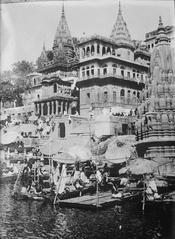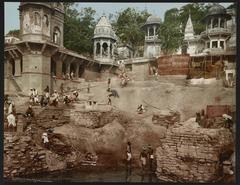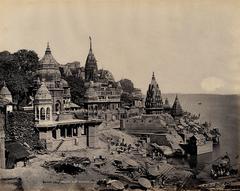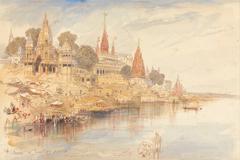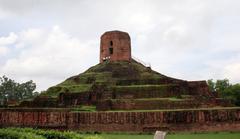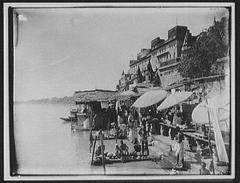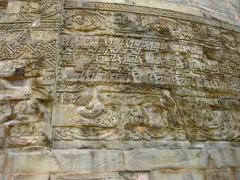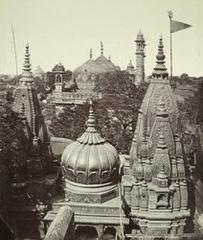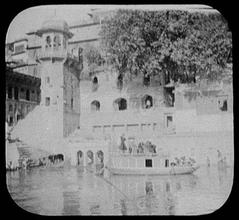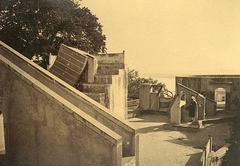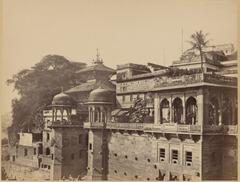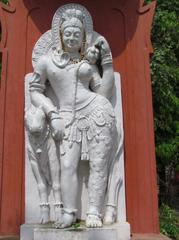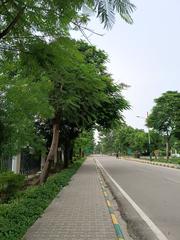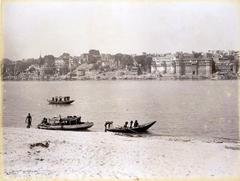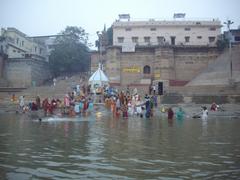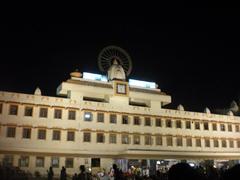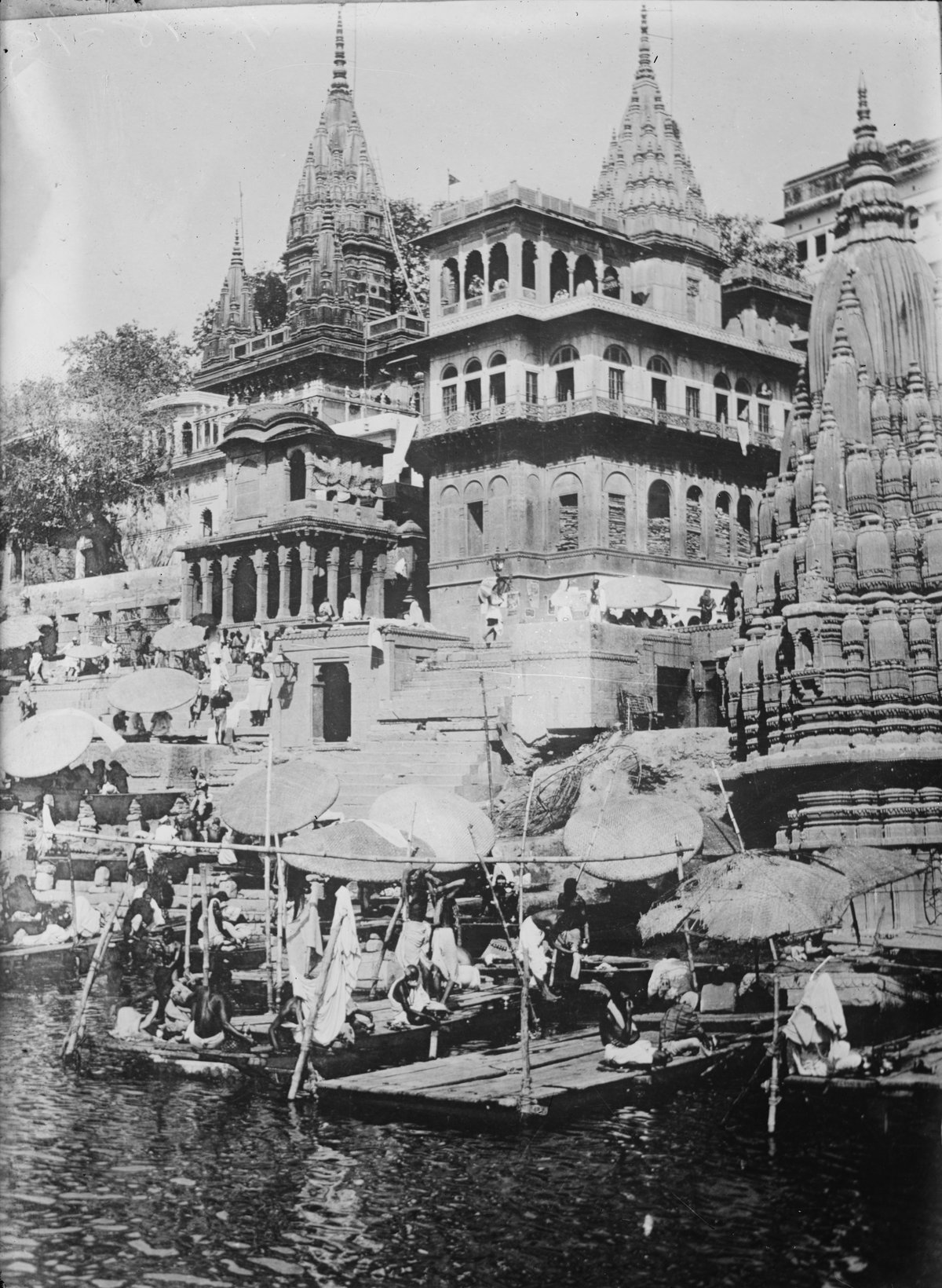
Manikarnika Ghat Varanasi: Visiting Hours, Tickets, and Comprehensive Guide
Date: 14/06/2025
Introduction
Manikarnika Ghat, located on the banks of the Ganges River in Varanasi, is the most sacred Hindu cremation ground and holds immense historical, cultural, and spiritual significance. Revered for its role in the cycle of life and death, the ghat is believed to grant moksha (liberation from the cycle of rebirth) to those cremated here. This guide provides an in-depth look at Manikarnika Ghat’s origins, rituals, visitor information, etiquette, accessibility, and surrounding attractions, ensuring a respectful and meaningful experience for pilgrims and travelers alike (Ancient Origins; visitvaranasi.in; aboutvaranasi.com).
Table of Contents
- Historical Origins and Evolution
- Mythological and Religious Significance
- Cremation Rituals: Step-by-Step
- Visiting Manikarnika Ghat: Practical Information
- Etiquette and Responsible Tourism
- Nearby Attractions
- Visitor FAQs
- Key Facts and Visitor Tips
- Conclusion
- References
Historical Origins and Evolution
Antiquity and Early Development
Manikarnika Ghat stands among the oldest ghats in Varanasi, with a history spanning over two millennia. The ghat’s origins are deeply rooted in Hindu mythology and are mentioned in ancient scriptures. Archaeological findings and textual references confirm its uninterrupted role as a cremation ground and spiritual site for thousands of years (Ancient Origins).
Varanasi, also known as Kashi, is home to approximately 87 ghats, but Manikarnika’s significance as a principal cremation ground predates many others, surviving numerous reconstructions and renovations over centuries (Ancient Origins).
Architectural Features
The ghat comprises wide stone steps leading to the river, flanked by shrines, the sacred Manikarnika Kund (a revered pond), and the marble Charanapaduka slab reputed to bear Lord Vishnu’s footprints. The infrastructure is designed for the continuous flow of cremation rituals, with specific areas for wood storage, pyre preparation, and ritual platforms (Ancient Origins).
Mythological and Religious Significance
Legends and Mythology
Several powerful legends contribute to Manikarnika Ghat’s sanctity:
- Vishnu and Shiva: According to legend, Lord Vishnu’s earring (mani) fell while he was digging a kund with his discus, hence the name ‘Manikarnika’ (mani = jewel, karnika = ear).
- Sati and Shiva: Another narrative speaks of Goddess Sati’s earring falling here when Lord Shiva carried her body, making it a powerful pilgrimage site (Ancient Origins).
Spiritual Purpose
Manikarnika Ghat is revered as a ‘tirtha’, a crossing point between the mortal and the divine. Hindus believe cremation here ensures liberation (moksha), freeing the soul from the cycle of rebirth. The site’s perpetual flames, tended by the Dom community, symbolize the eternal cycle of life and death (Experience My India).
Cremation Rituals: Step-by-Step
The Role of the Dom Community
The hereditary Dom community oversees all cremation rites, maintaining the sacred flame and ensuring the proper observance of rituals (visitindia.co; easeindiatrip.com).
Cremation Process
- Arrival and Preparation: The body, wrapped in a white shroud (sometimes adorned with garlands), is brought to the ghat and bathed in the Ganges.
- Pyre Construction: Wooden logs—sandalwood for wealthier families—are stacked, and the body is placed atop. Ghee is applied to aid combustion and purity (backpackersintheworld.com).
- Rituals and Ignition: The eldest son or male relative, often after a symbolic head-shaving, lights the pyre using the eternal flame. Priests chant mantras to guide the soul (pilgrimsindia.com).
- Final Rites: The process lasts several hours. Ashes and bone fragments are later collected and immersed in the Ganges, signifying the soul’s final release (pilgrimsindia.com).
Ritual Exceptions
Children, pregnant women, holy men, and victims of unnatural death are generally not cremated here but buried, following different customs (Ancient Origins).
Visiting Manikarnika Ghat: Practical Information
Visiting Hours
- Open 24 hours, year-round, with cremation rituals occurring continuously (aboutvaranasi.com; easeindiatrip.com).
- Best time: Early morning (6:00–10:00 AM) or evening (4:00–7:00 PM) for a meaningful, less crowded experience.
Entry Fees
- Free entry; no tickets required. Donations for cremation wood are voluntary and not compulsory (easeindiatrip.com).
How to Reach
- Location: Ghasi Tola Road, Varanasi 221001 (Trip.com).
- Access: Navigate through narrow alleys (on foot or rickshaw), or via boat from nearby ghats for panoramic views (templeyatri.in).
- Vehicles are not allowed beyond Godolia Chowk.
Accessibility
- The ghat features steep, uneven steps and crowded alleys, making access challenging for differently-abled visitors. Boats and assisted tours may help, but mobility is limited (apnayatra.com).
Etiquette and Responsible Tourism
Dress Code and Conduct
- Dress modestly: Both men and women should cover shoulders and knees (krazybutterfly.com).
- Remove footwear before entering temples or ritual areas.
- Maintain silence: Avoid loud conversations and laughter.
- Do not interrupt families or priests during rituals.
Photography and Filming
- Prohibited at cremation sites and of mourners; permitted only from a respectful distance or on the river (krazybutterfly.com; lucyliveshere.com).
- Always ask for permission before photographing people or rituals.
Interacting with Locals
- Use only licensed guides; confirm fees in advance (templeyatri.in).
- Avoid touts and unofficial guides offering “secret access” or demanding donations.
Health and Safety
- Air quality may be poor near cremation pyres; those with respiratory issues should take precautions.
- The area is crowded and can be overwhelming; exercise caution, especially at night and during festivals.
Responsible Tourism
- Protect the Ganges: Avoid plastic, use biodegradable offerings, and never pollute the river (LinkedIn).
- Support local artisans and businesses; consider quiet donations to local charities or temples.
Nearby Attractions
- Dashashwamedh Ghat: Famous for the evening Ganga Aarti (TripXL).
- Kashi Vishwanath Temple: Revered Shiva temple (non-Hindus may not enter sanctum) (Travelopod).
- Manikarnika Kund: Sacred well with mythological origins (Rajasthan Tour Planner).
- Ramnagar Fort: 18th-century fort with river views (entry fees: ₹50 Indians/₹100 foreigners) (TripXL).
- Sarnath: Major Buddhist site, 10 km from Varanasi (TravelTriangle).
- Assi Ghat: Popular for yoga and cultural events (Travelopod).
- Bharat Kala Bhavan: Museum of Indian art (TripXL).
- Harishchandra Ghat: Another significant cremation ghat (Rajasthan Tour Planner).
Visitor FAQs
Q: What are the visiting hours of Manikarnika Ghat?
A: Open 24/7, but daylight hours (6 AM–6 PM) are preferable.
Q: Is there an entry fee?
A: No, entry is free; donations are voluntary.
Q: Can tourists take photographs?
A: Strictly prohibited during cremations; permitted only in designated areas with permission.
Q: How do I reach the ghat?
A: On foot or by rickshaw through old city alleys, or by boat from nearby ghats.
Q: Is the ghat accessible for differently-abled visitors?
A: Accessibility is limited; consider assistance or boat access.
Key Facts and Visitor Tips
- Cremations: 80–300 daily; the busiest cremation ghat in India (Ancient Origins).
- Continuous flame: Tended by the Dom community for centuries.
- No tickets: Free entry, but be wary of scams.
- Dress code and etiquette: Essential for all visitors.
- Best visiting months: October–March for pleasant weather.
- Boat rides: Offer unique perspectives at sunrise or sunset (Riteshritfriends).
Conclusion
Manikarnika Ghat is not just a cremation ground but the spiritual epicenter of Varanasi, encapsulating the city’s ancient traditions, mythology, and reverence for the eternal journey of the soul. A visit demands respect, humility, and awareness of local customs. By following the guidelines in this guide, visitors can experience the profound spiritual atmosphere, learn about India’s rich religious heritage, and contribute positively to the preservation of this timeless site.
For the latest travel tips, detailed guides, and immersive content on Varanasi, download the Audiala app and follow our updates on social media.
References
- Ancient Origins - Manikarnika Ghat and the Role of Cremation in Traditional Indian Funerary Rites
- Visit Varanasi - Manikarnika Ghat
- Experience My India - Manikarnika Ghat in Varanasi: History, Rituals, and Visitor Guide
- About Varanasi - Manikarnika Ghat in Varanasi, Uttar Pradesh
- Ease India Trip - Cremation Ceremony at Manikarnika Ghat: Respectful Guide
- Rajasthan Tour Planner - Manikarnika Ghat Varanasi: Visiting Hours, Tickets & Nearby Historical Sites
